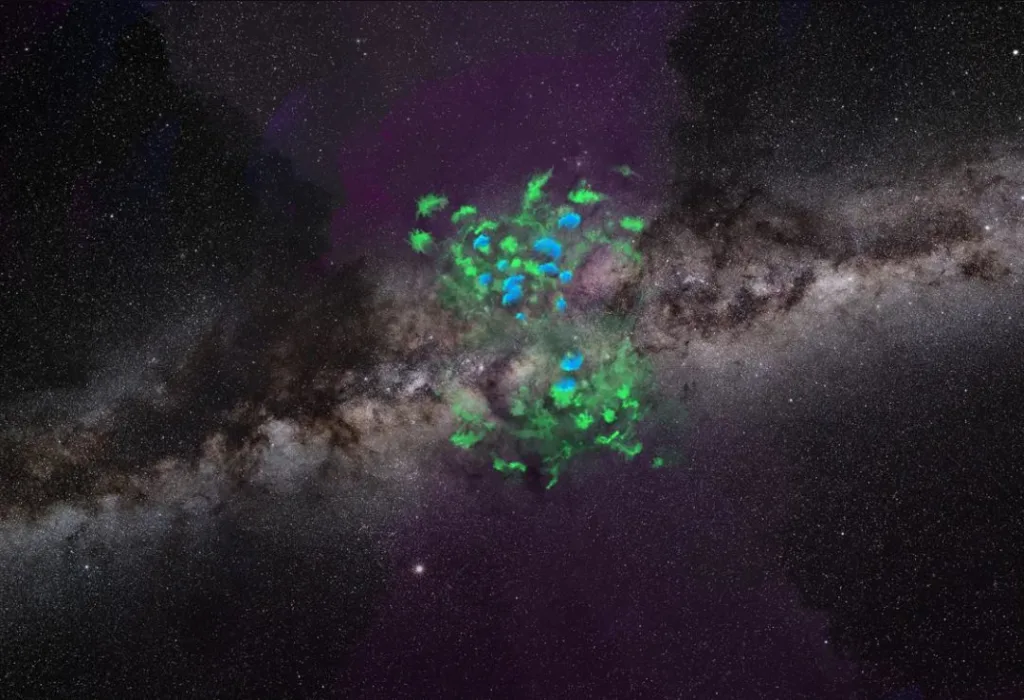

Gas Clouds Dancing Across the Milky Way
The Green Bank Telescope, operated by the National Science Foundation, has made a groundbreaking discovery, detecting more than 250 gas clouds forcefully expelled from the core of the Milky Way into the vastness of interstellar space. This revelation was unveiled at the 243rd meeting of the American Astronomical Society (AAS) in New Orleans, marking a significant advancement in our understanding of galactic dynamics. A mere ten years ago, astronomers were oblivious to this celestial phenomenon, and it took years of meticulous observations, along with some unexpected findings, to arrive at this latest revelation.


The energetic processes within the Milky Way’s center have long been recognized for generating fast, scorching winds that extend into intergalactic space, boasting temperatures in the millions of degrees and velocities in the thousands of kilometers per second—similar to such phenomena observed in most large galaxies.
An accidental revelation occurred when the Australian ATCA telescope, measuring the 21cm radio emission emitted by interstellar hydrogen atoms, discovered that some of the outgoing hot gas had entrained cold hydrogen clouds. This surprising find suggested the existence of an undiscovered population of clouds carrying matter away from the Milky Way’s nucleus.
Beyond their inherent importance, these hydrogen clouds serve as invaluable probes of the hot wind. While measuring conditions within the searing hot wind proves challenging, the cooler clouds act as indicators, analogous to leaves tossed in the air on Earth revealing the direction and speed of the local wind.
The Green Bank Telescope’s remarkable sensitivity positioned it as the ideal tool for detecting faint signals from interstellar hydrogen. However, mapping these clouds and comprehending their true scope presented a formidable challenge. Jay Lockman, senior astronomer at the Green Bank Observatory, commented, “It took years using the GBT to systematically map hundreds of square degrees in search of faint hydrogen emission. Upon identifying a few interesting possibilities, we might proceed with focused observations at other telescopes to provide further information.”
Lockman explains that these clouds were likely torn from an area near the Milky Way’s center, propelled outward by either a burst of star formation or the activity of a black hole. Some of these clouds exhibit the highest outflow velocity ever observed in the Milky Way and may even escape the galaxy.
In an unexpected twist, the APEX telescope in Chile uncovered data revealing that some hydrogen clouds contain molecules and dense cold gas. Lockman remarked, “No one would have expected that clouds violently ejected from the Milky Way could harbor relatively fragile molecular material, but there it is”.
Recent observations by the MeerKAT array in South Africa further detailed the evolution and fragmentation of these hydrogen clouds as they traverse interstellar space.
These groundbreaking findings not only deepen our understanding of galactic dynamics but also pose intriguing questions about the stability and chemical processes within these rapidly accelerating clouds, exceeding speeds of 400 kilometers per second. As Lockman aptly puts it, “The chemical processes in these clouds are quite unusual and unexplored”, leaving the door wide open for more discoveries and revelations in the realm of astrophysics.


What is a Gas Cloud?
Imagine a celestial art gallery in the vast canvas of space, where the brushstrokes aren’t strokes at all but clusters of gas particles suspended in the cosmic void. That’s a gas cloud for you – a breathtaking tapestry of hydrogen molecules and cosmic hues, ranging from the subtle to the majestic.
Not only are these hazy clouds aesthetically pleasing, but they also serve as the cosmic nurseries from which stars emerge, contributing significantly to the vast dance of heavenly creation. One gas cloud at a time, astronomers are discovering the mysteries of the cosmos by examining these celestial beauties with great enthusiasm.
Giant Gas Cloud Description
Picture this – giant gas clouds, the celestial behemoths stretching across the cosmic stage, putting on a show that captivates the imagination. These colossal formations, mostly made of hydrogen, are like the rockstars of the universe, flaunting vibrant colors, diverse shapes, and densities that keep astronomers glued to their telescopes.
It’s not just about their looks; these giant gas clouds are the cosmic sculptors, shaping the galaxies with the birth of new stars. The study of these gigantic celestial formations is like peeling back the layers of the universe, revealing the magic that happens on an astronomical scale.
Giant Gas Cloud Stage
Let’s dive into the cosmic drama of a giant gas cloud’s life – it’s a saga with stages that mirror the ups and downs of life itself.
Dormancy:
In the beginning, our giant gas cloud is like a cosmic daydreamer, peacefully drifting through space. Gravity plays matchmaker, subtly bringing gas particles closer, setting the stage for what’s to come.
Compression:
Suddenly, our cloud is caught in a celestial embrace. Forces from all sides, like shockwaves from exploding stars or cosmic collisions, kickstart a party within the cloud. Some regions get cozy, heating up and becoming denser, creating the perfect conditions for cosmic mischief.
Star Formation:
And then, the grand finale – star birth! Imagine a burst of fireworks as certain pockets in the cloud collapse under gravity’s spell, giving birth to brand-new stars. These stellar nurseries are like the bustling maternity wards of the cosmos, shining brightly and painting the space around them with their stellar glow.
Dispersal:
As the curtain falls, our giant gas cloud gracefully disperses its enriched legacy. It’s a poetic exit, releasing elements forged within stars back into the cosmic ballet. This dispersal makes sure that the fate of celestial bodies across the galaxy is shaped by the massive gas cloud’s tale, which forms a part of the cosmic cycle. Comprehending these phases is not only about solving the universe’s riddles; it’s about sensing the universe’s pulse.





